How to Track an Amazon Package in 2024
Learn how to track an Amazon package in 2024 with easy steps to find your tracking number, understand statuses, and handle common delivery issues.
Home > Blog > How to Compete with Amazon Delivery As a Small Business [2024]
Retail and E-CommerceAmazon is a force to be reckoned with. And if you want to survive, you need to know how to compete with Amazon shipping and delivery. Here's how!
When it comes to retail and delivery, Amazon is a force to be reckoned with.
It’s the undisputed champion of online retail sales, and its share is growing each year.
Not even companies like eBay, Apple, Shopify, Walmart, Rakuten, or any other giant can rival them.
So then, how can you compete against Amazon in 2024?
In truth, you can’t. And you shouldn’t!
Instead, you should adapt your delivery and learn how to work with Amazon.
And there are more than a few ways you can achieve that.
When it comes to shipping and fulfillment, you can’t compete with Amazon.
No one can!
Strictly speaking, not even Amazon fulfillment can rival Amazon.
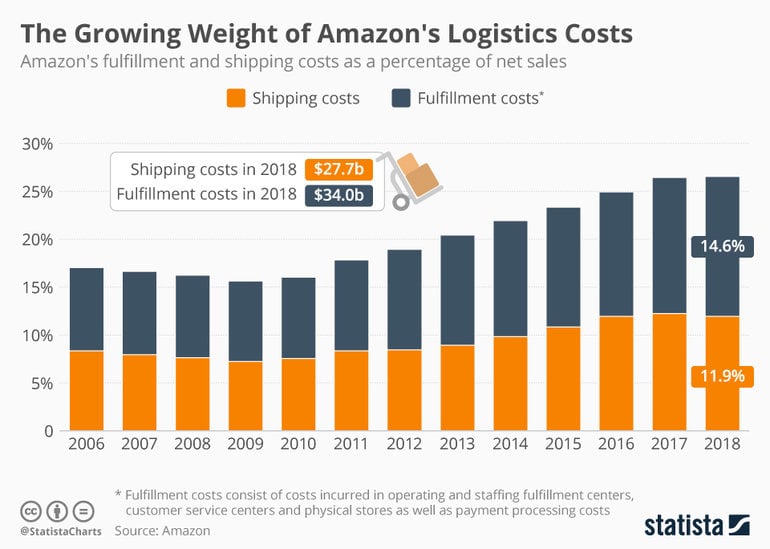
And that’s the point.
Amazon’s are regularly a substantial chunk of their revenue. In 2019, the company spent 40.23 billion on shipping. A few years later, in 2023, the number spent on shipping amounted to 90.61 billion.
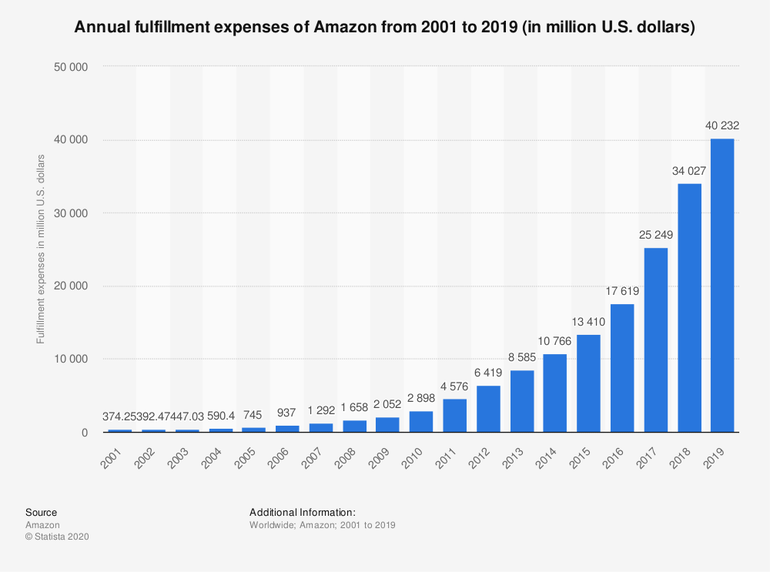
But Amazon doesn’t need to cut its losses. It can sacrifice profit because it has other revenue streams that make up for that.
So, the goal can’t be to compete with Amazon. All you need is to stay in the race.
But Amazon was never the real problem.
The crux of the matter lies with your customers. Amazon was just the spark that ignited the fire.
What Amazon did was change the game by shedding light on what consumers want and giving it to them.
It’s a run-of-the-mill supply vs. demand situation. Amazon just took advantage of it.
And what do they provide?
Amazon offers customers speed, low prices, availability, free delivery, convenience, fast and easy payment (among many other things) with EVERY DELIVERY.

They created ON-DEMAND DELIVERY. That’s what you’re up against.
But that’s something you can compete with.
And to do that, you need to learn how to improve delivery operations and focus on meeting customer expectations by providing a service your customers want.
It’s no secret that in-store shopping is in decline.
As we speak, retail store sales are plummeting, while sales from online shopping continue to climb.
(And we all know who is the winner there)

But that doesn’t mean that your bricks and mortar store is at an idle loss when you compare it to your webshop.
Quite the opposite. A physical store remains a vital link in your supply chain.
You can leverage these two features to improve fulfillment in your local area.
While Amazon has to build huge warehouses to store its vast inventory and workforce to service your community, all you have to do is repurpose your store (or at least part of it).
Instead of having two separate storage/pick-up sites, or investing in a new depot location, you can use the store as a warehouse.
Besides cutting down costs, it also increases the efficiency of your delivery.
If you operate your service locally, a brick and mortar store can increase the speed and efficiency of your last-mile delivery.
On the other hand, if your delivery has to cover a larger area, opening a different depot site lets you divide the range of operations into zones and reduce the stress on your capacities.
And while Amazon might offer cheaper deals, they won’t be able to match the service standard, nor the rate of fulfillment. (At least among the locality)
Focus on Selling Unique or Niche Products
Amazon’s vast product catalog makes it challenging for resellers to compete with popular items like game consoles, which are already dominated by big brands.
Instead, prioritize selling products that are unique or cater to a specific niche. This allows you to target a well-defined audience and stand out from the generic offerings on Amazon. If possible, consider developing your own products to carve out a distinctive space for your brand in the market.
If you ask your customer what does he or she want from a delivery, most will answer a great customer experience.
But what makes a great customer experience great?
In 2020, PwC carried out a survey about the future of CX to find out. They asked consumers:
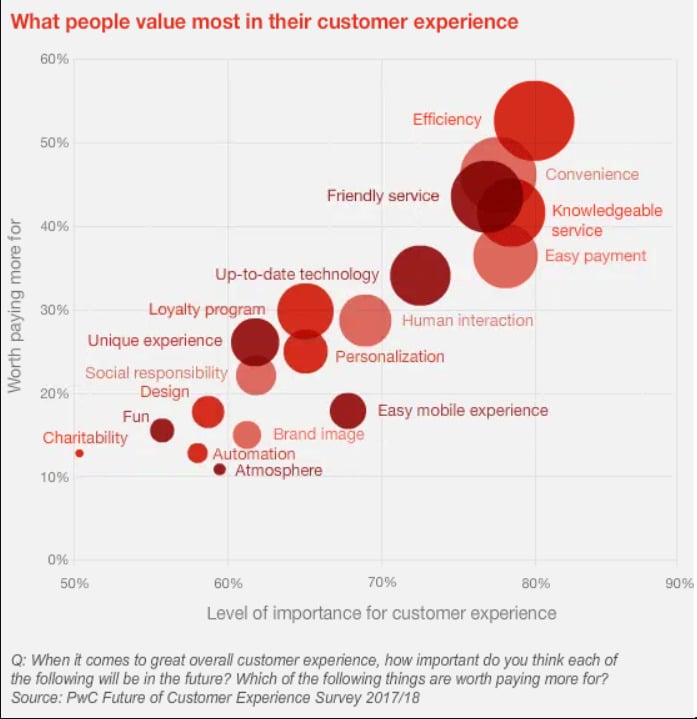
Above the fold is convenience.
A typical customer wants to receive his delivery as FAST as possible and to choose the DATE and TIME when it arrives. (Preferably, with a +/- 30-minute gap)
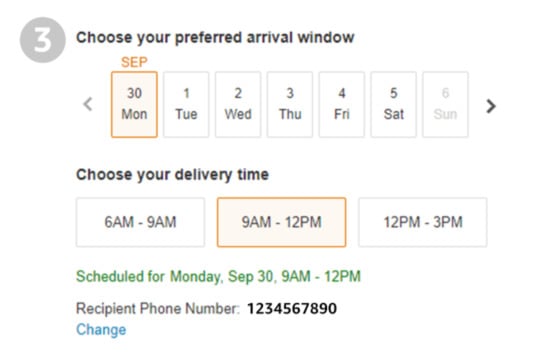
Unless you are Amazon, this is not practical from a business point of view. So, it has to be a balance of convenience and efficiency.
A good thing to remember is that customers are willing to pay for that level of service.
If you can give them the option to choose a date and time of day when you can deliver them the order, they won’t mind the cost of shipping.
This can significantly streamline the checkout flow and possibly reduce your shopping cart abandonment rate.
Keeping them in the loop about their delivery is another convenience customers look for in a great service.
An easy way to do this is with delivery management software, like eLogii.
Integrating this digital tool into your delivery operation lets you automate scheduling, dispatch, and routing, and makes it easier to plan delivery around drop-offs.
This works both when you want to allow customers to hand-pick the date and time of arrival, and when you want to notify them about the location of their delivery.
For the best experience, a customer service operative can send a tracking link to the customer.
Now, take a closer look at the previous graph again. What do you see?

Listed right there at the top are a friendly and knowledgeable service, personalization, and human interaction.
This is where Amazon fails in comparison and where your brand has the upper hand.
Because of tight schedules, fear of penalties, and rumored poor treatment of its workforce, Amazon’s staff doesn’t have the time or motivation to nurture a customer relationship that has those qualities.
Not even Prime members receive more than a simple “Hello. Delivery for John. Sign here. Thank you. Bye.”, which is a far cry from what customers expect at their doorstep.
However, you and your drivers don’t operate under the same burden. And that means you can take better care of your customers.
If you include a time window for drop-off and equip drivers with a delivery app that lets them communicate with customers directly, they can leave a good impression and nurture relationships with your customers.
Imagine a driver in a clean uniform who sends a message saying “I’m on my way” or “I’ll arrive in X minutes”, knows my name, and has the time to exchange a few words.
As a customer myself, I know I would be more than happy to do business again with that company.
A personal touch like that is all it takes to provide value for customers and create a memorable experience, regardless of what Amazon has on offer.
Plus, you can count on positive reviews and ratings.
Once word gets around your customers will attract new customers, without you even lifting a finger.
After all, there is no better marketing than word-of-mouth.
Amazon has set the bar for fast and hassle-free checkouts. If your checkout process requires lengthy forms or multiple steps, customers are more likely to abandon their carts than complete their purchases.
To prevent this, make your checkout process straightforward and user-friendly. Streamline your portal and offer multiple payment options, such as PayPal, to provide a smoother experience for your customers.
One reason Amazon became so successful is its free and dependable returns policy for many products.
While the idea of offering free returns might seem daunting, it’s a powerful way to build trust with your customers. It demonstrates confidence in your products and shows that your priority is customer satisfaction. A straightforward and fair returns policy can make a big difference in encouraging purchases.
One of the biggest reasons Amazon is so successful is the way it offers delivery options to its customers.
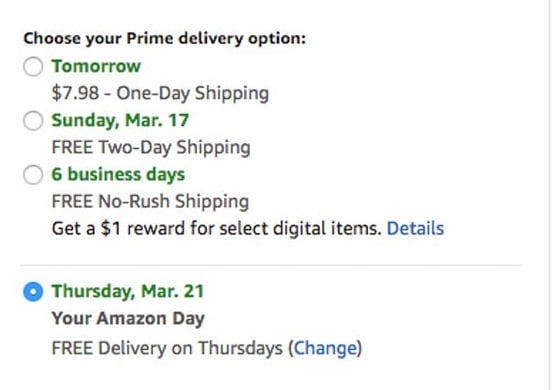
Let’s face it, who wouldn’t want to get free two-day shipping?
For retailers, this is bad news.
As a company that provides the delivery services, that’s simply too expensive (even for giants like Walmart).
By raising customer expectations when it comes to fulfillment, Amazon has forced those same expectations onto everyone else in the retail industry.
But the goal still isn’t to compete against Amazon (or Walmart for that matter), it’s to offer as much convenience and customer service as your resources and capabilities permit.
Consumers love free shipping. In fact, until 2020, it’s the number one reason why 79.8% of shoppers in the US picked Amazon.
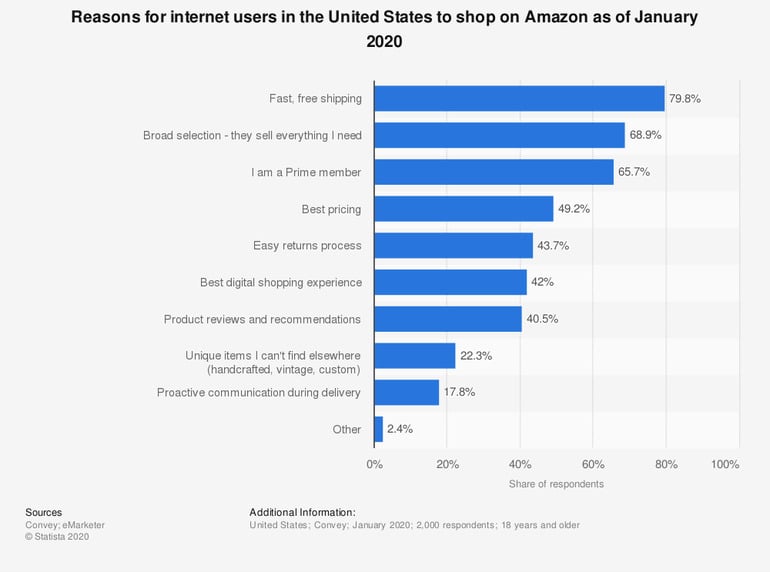
In March 2024, 48% of surveyed U.S. shoppers said they choose Amazon mainly for free shipping. Another 44% cited convenience, and 36% valued quick delivery.

And while you probably don’t have the resources to match Amazon fulfillment, there are ways you can make your shipping deals more enticing.
One of the best ways (even at the smallest scale) is to offer free or discount shipping above a certain price threshold.
A survey from 2017 found out that 48% of consumers are more likely to add items to their shopping cart to qualify for free shipping. While a case study by Red Door discovered that adding a free shipping threshold can increase orders by 90%.
So, despite a high investment requirement, it is still highly likely that you will see a substantial return on it.
For example, Typo offers free shipping for orders over £25. But it also includes exceptions and limits their offer only to the United Kingdom. This ensures they maintain profitability even when shipping products for free.

Another way to provide free shipping is to create loyalty-based incentives for returning customers, similarly to Amazon Prime membership.
Not only is it a great way to retain your customers and fend off Amazon, but creating a fanbase around your brand is a far more lucrative option than attracting new customers.
Additionally, you can include free delivery as an add-on or gift as part of your delivery offer.
For example, if you have an expensive product or a product that doesn’t sell often you can incentivize customers to buy it by offering to deliver it for free.
You can do this also for products that are cost-effective and easy to deliver, and even for your best selling items (as they have the best chance to bring in more new customers).
If none of this is achievable (or affordable), then stick to a flat service rate for all your deliveries.
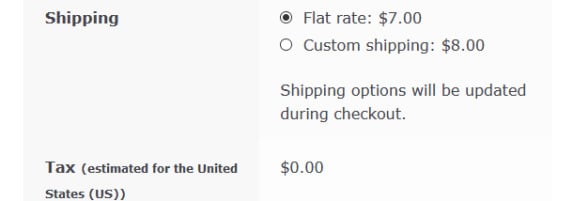
Even though you are not offering free delivery, sticking to the same shipping price regardless of the volume, motivates customers to purchase more products.
After all, two items for the same price of delivery is better than one.
Shoppers don’t have the patience anymore to wait for weeks to receive their orders.
Almost half or 44% of consumers want their purchase to arrive within two days from when they place a delivery order.
However, Amazon’s move towards free same-day delivery for Prime members means they have reset the game.
The bad news is consumers are now even more anxious to get their orders faster than before.
But the good news is they don’t mind paying for it.
In fact, 88% of consumers are willing to pay more on their orders if it means receiving same-day delivery or faster shipping.
And if you can supply your customers with faster delivery options, this is a great opportunity to give Amazon a run for their money.
Luckily, there is one area of delivery where you are already better than Amazon, the local last mile.
The HUGE size of Amazon’s global operations means their logistics network is stretched too thinly to cover deliveries at all locations at the same speed (at least for now).
If you focus on providing fast and consistent same-day delivery to your nearest customers, you can survive and even thrive in spite of Amazon’s dominance.
But to do it, you will need to focus your energy on rapid end-to-end fulfillment and work to reduce delivery cycles.
The best way to achieve this is to rethink your delivery strategy to remove non-essential steps in the process and optimize your operations via automation.
Optimizing delivery fulfillment isn’t a quick nor easy way to fight off Amazon.
But in the long run, it repays itself manifold.
And when it comes to optimization, technology is the key.
According to Gartner, apart from customer service, the biggest priorities for retailers in 2018 and 2019 involved some level of supply chain optimization using technology.

The best way to automate delivery is through delivery management software.
The best delivery management software platforms offer end-to-end features and capabilities, from route optimization and depot management to customer service and even reverse logistics.
Systems like eLogii support API integration, a cornerstone of API-based commerce which has been labeled among the top emerging trends in digital commerce in 2024.
These features allow you to reduce costs and increase visibility by streamlining the delivery process and removing the unnecessary waste of resources.
For example, optimizing routes for delivery drivers compresses delivery cycles, which enables them to complete more deliveries and promotes rapid fulfillment.
Increasing profit and productivity and reducing cost through optimization releases resources to develop other solutions that we’ve mentioned, like improving your shipping offer or customer service.
Ultimately, this is what enables you to drive home an Amazon-style experience with all the perks and benefits of your brand.
Even more importantly, it is what will allow you to retain customers and attract new ones in the age of Amazon delivery.

Amazon attracts shoppers with low prices, fast shipping, and secure returns. Competing against this requires offering something uniquely valuable to your customers.
Focus on providing exclusive perks, such as unique product variations, extended warranties, or limited-time deals. Avoid simply mimicking competitors—what works for them might not work for you. Instead, analyze strategies from other industries to find creative solutions.
For example, many hotels incentivize direct bookings by offering rewards, discounts, and flexible cancellation policies that third-party platforms don’t provide. Similarly, you can create exclusive benefits for customers who shop directly with you.
Another advantage of bypassing large marketplaces like Amazon is retaining full control of your brand experience. From product packaging to customer service, you can ensure a consistent, high-quality interaction that reflects your brand’s identity. By offering these unique advantages, you give customers a strong reason to shop with you in 2024.
%20(1).webp?width=635&height=353&name=elogiisoftware%20(2)%20(1).webp)
Why not leverage the #1 route optimization solution for deliveries to give your small business a competitive edge against Amazon in 2024?
Efficient route planning software can help you streamline deliveries, reduce fuel costs, and ensure faster order fulfillment—all crucial factors in meeting customer expectations.
By optimizing delivery routes, you can:
This not only helps you compete with Amazon's fast shipping but also establishes your brand as a reliable and efficient choice for local deliveries.
In retail, Amazon faces competition from stores like Target, Walmart, Best Buy, and Costco. For subscription services, its rivals include Netflix, Apple, and Google.
Amazon often offers the lowest product prices, making it hard for smaller businesses to compete. Matching Amazon's prices can be unprofitable for smaller companies, as they don't have the same volume of sales to offset lower margins.
“The Amazon standard” represents the high bar Amazon has set in e-commerce logistics. This includes fast delivery options like same-day or next-day shipping, hassle-free return processes, advanced warehouse automation, real-time tracking, and outstanding customer service.
Modern fulfillment operations must adapt to higher consumer expectations shaped by “the Amazon standard.” This requires investing in advanced technology, optimizing processes, and prioritizing a fast, reliable, and customer-focused shopping experience to stay competitive.

Learn how to track an Amazon package in 2024 with easy steps to find your tracking number, understand statuses, and handle common delivery issues.
Learn how to track orders, packages, and parcels with UPS, USPS, DHL, FedEx, Amazon, and more, and how to offer order tracking to your customers.
Explore how to secure next-day delivery on Amazon, with or without Prime. Learn about eligibility, costs, and tips for efficient ordering.
Be the first to know when new articles are released. eLogii has a market-leading blog and resources centre designed specifically to help business across countless distribution and field-services sub sectors worldwide to succeed with actionable content and tips.
